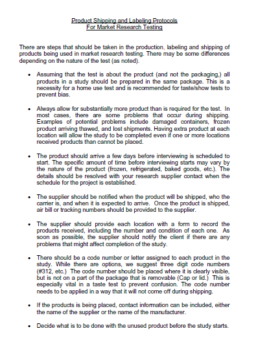Product Shipping and Labeling Protocols For Market Research Testing
There are steps that should be taken in the production, labeling and shipping of products being used in market research testing. There may be some differences depending on the nature of the test (as noted).
- Assuming that the test is about the product (and not the packaging,) all products in a study should be prepared in the same package. This is a necessity for a home use test and is recommended for taste/show tests to prevent bias.
- Always allow for substantially more product than is required for the test. In most cases, there are some problems that occur during shipping. Examples of potential problems include damaged containers, frozen product arriving thawed, and lost shipments. Having extra product at each location will allow the study to be completed even if one or more locations received products than cannot be placed.
- The product should arrive a few days before interviewing is scheduled to start. The specific amount of time before interviewing starts may vary by the nature of the product (frozen, refrigerated, baked goods, etc.). The details should be resolved with your research supplier contact when the schedule for the project is established.
- The supplier should be notified when the product will be shipped, who the carrier is, and when it is expected to arrive. Once the product is shipped, air bill or tracking numbers should be provided to the supplier.
- The supplier should provide each location with a form to record the products received, including the number and condition of each one. As soon as possible, the supplier should notify the client if there are any problems that might affect completion of the study.
- There should be a code number or letter assigned to each product in the study. While there are options, we suggest three digit code numbers (#312, etc.) The code number should be placed where it is clearly visible, but is not on a part of the package that is removable (Cap or lid.) This is especially vital in a taste test to prevent confusion. The code number needs to be applied in a way that it will not come off during shipping.
- If the products is being placed, contact information can be included, either the name of the supplier or the name of the manufacturer.
- Decide what is to be done with the unused product before the study starts.
- If respondents are being given multiple products to use at home, the optimal method would be to use sequential placement (not give the respondents the second product until they have used the first product). In many cases, this is not economically feasible. If multiple products are placed simultaneously, the order of trial (USE FIRST, USE SECOND) should be included on the packages placed.
- Frequently, product is shipped directly from the manufacturer to the testing location. Regardless of the how the product is being placed, samples can be sent to the supplier. Manufacturers and Suppliers should always save retention samples of products until the results have been reported and finalized.
- There are special considerations for shipping frozen products. Frozen products are generally shipped on dry ice. If possible, there should be enough dry ice in the package to last at least 24 hours. It is best to ship frozen products to arrive on Tuesday, Wednesday or Thursday. If the product is shipped on dry ice, sufficient time must be allowed before starting the test to allow the product to return to freezer temperature before it is tasted.
- There are some shelf stable products that need to be shipped in controlled conditions. For example, if chocolate candy is shipped in warm weather or to warm weather locations, it should be packaged in insulated containers and may require cooling packs be enclosed.) Baking goods that need to stay fresh may need to be prepared and shipped more than once and may need to be protected from extreme hot and cold.)
- There may be altitude conditions to consider when shipping products. This can affect how the product is shipped and what locations are included in the test. There have been situations where products exploded during air shipment or when arriving at high altitude locations (like Denver) when these factors were not considered.

